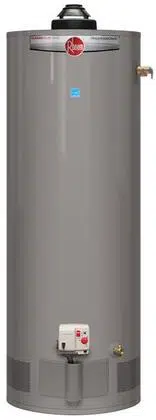Loading ...
Loading ...
Loading ...

High Altitude
Pressure Testing the Gas Supply System
The water heater and its individual shut-off
valve must be disconnected from the gas
supply piping system during any pressure
testing of that system at test pressures in
excess 1/2 psi (3.5 kPa).
The water heater must be isolated from the
gas supply piping system by closing its
individual manual gas shutoff valve during
any pressure testing of the gas supply at
test pressures equal to or less than 1/2 psi
(3.5 kPa).
11
Vent and Combustion Air-Inlet
This water heater is a direct vent appli-
ance and must be installed so that all air
for combustion is derived directly from the
outside atmosphere and all flue gases are
discharged to the outside atmosphere. For
proper installation of the vent and combus-
tion air-inlet systems, follow the instruc-
tions as detailed in this manual. DO NOT
connect this water heater to an existing vent
or chimney - it must be vented separately
from all other appliances.
NOTICE: This water heater is approved
to use the following materials for pipe
of the vent and combustion air-inlet sys-
tems:
PVC (Schedule 40, Cellular Core,
ASTM-F891)
PVC (DWV, ASTM-D2665 or
CSA B181.2)
PVC (Schedule 40, ASTM-D1785 or
CSA B137.3)
PVC (SDR Series, ASTM-D2241 or
CSA B137.3)
CPVC (CPVC 4120, ASTM-D2846 or
CSA B137.6)
CPVC (Schedule 40, ASTM-F441 or
CSA B137.3)
CPVC (SDR Series, ASTM-F442)
ABS (Schedule 40, DWV, ASTM-D2661 or
CSA B181.1)
ABS (Schedule 40, DWV, Cellular Core,
ASTM-F628)
This water heater is approved to use the
following materials for the fittings of the
vent and combustion air-intake systems:
PVC (Schedule 40 DWV, ASTM D2665)
CPVC (Schedule 40, ASTM F438)
ABS (Schedule 40 DWV, ASTM D2661)
DO NOT mix ABS pipe and fittings with
PVC or CPVC pipe fittings. Note: It
is acceptable to interchange PVC and
CPVC pipe and fittings.
Vent and combustion air-inlet systems must
be adequately supported along both vertical
and horizontal lengths.
The vent and combustion air-inlet sys-
tems of this water heater may be installed
horizontally through a wall or vertically
through the roof.
Maximum unsupported length is recom-
mended to be no more than 4 feet (1.22 m).
It is imperative that the first hanger be
located on the horizontal length immedi-
ately adjacent to the first 90-degree elbow
from the vertical rise of vent pipe connect-
ed to the water heater.
DANGER: Failure to
properly install the vent
and combustion air-inlet
systems as outlined in the
Vent and Combustion Air-
Inlet section of this
manual will result in
unsafe operation of the
water heater causing
bodily injury, explosion,
fire or death.
To avoid the risk of fire,
explosion, or asphyxiation
from carbon monoxide,
NEVER operate the
water heater unless it is
properly vented and the
vent and combustion air-
inlet systems are properly
installed as detailed in the
"Vent and Combustion
Air-Inlet" section of this
manual.
The vent and combustion
air inlet pipes must
overlap a minimum of 1/2
in. (1.3 cm) at each joint.
It is important that the
vent and combustion air-
inlet pipes engage fully
into any pipe fitting and
be kept in that position
until the adhesive has
fully cured. DO NOT
drill or punch holes in the
plastic pipe or fittings.
Input rating of this water heater is based on
sea level operation. At higher elevations
the actual input rate may be lower than the
value listed on the rating label due to the
derating of Natural Gas and LP Gas. For
Power Direct Vent models listed in the
venting tables that do not show venting
configurations above 7,700 ft. (2,347 m),
contact the water heater manufacturer for a
required High Altitude Kit that will allow
the specific water heater model to operate
at altitudes between 7,700 ft. (2,347 m) and
10,200 ft. (3,109 m). See page 44.
!
WARNING: Failure
to install a water heater
suitable for the altitude at
the location it is intended
to serve, can result in
improper operation of
the appliance resulting
in property damage and/
or producing carbon
monoxide gas, which
could result in personal
injury, or death.
Loading ...
Loading ...
Loading ...
